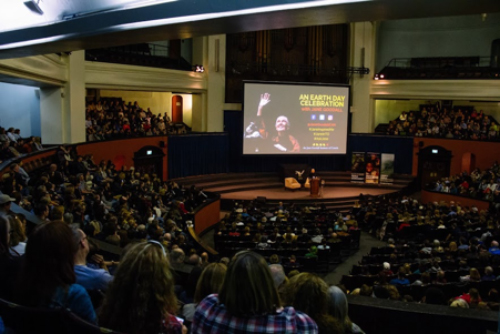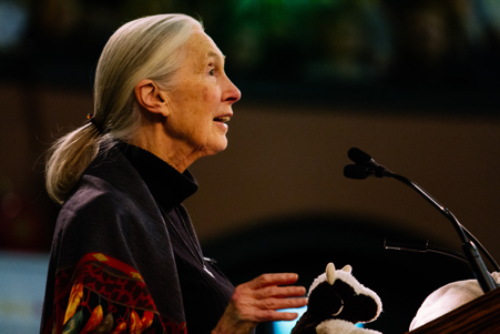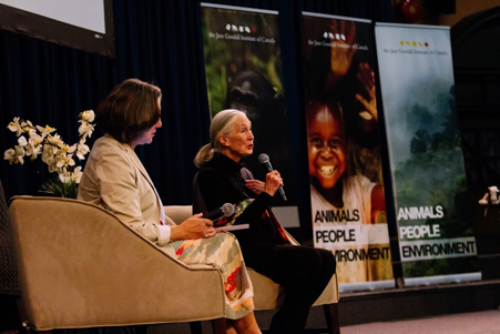Farah Qaiser, Policy & Politics co-editor
On Sunday, April 22, 2018, Jane Goodall celebrated Earth Day at the University of Toronto with a short talk, followed by a Q&A with Andria Teather, CEO of the Jane Goodall Institute Canada.
Goodall is a British primatologist who is best known for her 55-plus years of studying the social and family interactions of chimpanzees. She is also heavily involved in activism, and founded the Jane Goodall Institute (JGI) in an effort to address issues related to conservation and animal welfare.
In April, Goodall returned to Canada for a series of events, including a fundraiser at the Toronto TIFF Bell Lightbox, the Earth Day celebration at the University of Toronto and a final event in Kitchener/Waterloo. All proceeds from these events will support future JGI Canada initiatives.
In this post, I’ll recap highlights from the Earth Day celebration at the University of Toronto.
@JaneGoodallCAN @JaneGoodallInst #janeinTO #EarthDay pic.twitter.com/qhZzMBHw8N
— Krishana:#150mins for diabetes awareness month (@KrishanaSankar) April 22, 2018
Tickets for this Earth Day celebration sold out almost immediately, and when the #JaneInTO event began with an audio clip of a chimpanzee greeting, there was an immediate standing ovation from the crowd.
https://twitter.com/AntoninoCalarco/status/988200787192045568
Goodall began her talk by thanking her mother, who helped nurture and encourage her curiosity from an early age. “I wanted to go back to the beginning to pay tribute to the person who’s really made my life possible – and that’s my mother”, she said. “We can’t choose our mothers. I just got lucky.”
Goodall highlighted her mother’s influence with a personal anecdote about when she fell in love with Tarzan (the book). “I fell in love with this glorious Lord of the Jungle. [I was] really, really jealous [of the Jane in the stories]. ‘Will you marry me, wrong-Jane?’” Goodall joked. “That was where my dream began. I would grow up, go to Africa, live with wild animals, and write books.”
While many laughed at the fantasy, her mother was supportive. Mrs. Goodall told Jane that if she really wanted her dream, she would have to work very hard and never give up. “That’s what she said to me – and so I worked very hard at school,” said Goodall. Unfortunately, there wasn’t enough money for her to attend college or university, so she attended secretarial college and then landed a job in London.
At this point in the talk, Goodall emphasized that everyone should be ready to grasp opportunities as they arise. In her case, while working as a secretary she received an opportunity to go to Kenya. She had to work longer hours and pick up odd jobs to afford the airfare, but managed to take advantage of this unique opportunity to finally achieve her childhood dreams.
Once in Africa, Goodall began exploring the local area, attending safaris, and soon found an opportunity to work as a secretary for Louis Leakey, the world-famous Kenyan palaeontologist. Under his direction, she began to study primate behaviour.
Goodall soon made breakthrough observations of chimpanzees making tools (such as adapting branches to fish termites out of a mound) and displaying similar social behaviour to humans. She described it this way: “I saw [the chimpanzee] pick leafy twigs and fashion them into tools. He had to remove the leaves and the little side branches […] It wouldn’t be exciting if you saw that today, but back then, it was still thought that humans and only humans used and made tools.”
She immediately sent a telegram to Leakey about this remarkable discovery. “He sent me back the message: ‘Now we must redefine ‘tool’, redefine ‘man’, or accept chimpanzees as humans’,” said Goodall.
But instead of acceptance from the scientific community, her observations were questioned and not taken seriously because Goodall had no credentials or prior field experience.
Goodall recruited a National Geographic Society photographer to film her observations. This was the evidence she needed to convince other scientists of what she had seen. Her findings were soon shared with the whole world. In 1965, National Geographic released the film Miss Goodall and the Wild Chimpanzees.
Goodall continued to survey chimpanzees, and commented on some of the trends she had observed. “I was very shocked when I discovered that chimps can be extremely violent and brutal, just like us,” she revealed. She also noted examples of their compassionate nature, such as when she saw adult chimpanzees adopting orphans.
Goodall eventually went to Cambridge University to pursue a PhD in ethology, under the supervision of Robert Hinde. She was the eighth person to be allowed to earn a PhD at Cambridge University despite having no undergraduate degree. As Goodall had no prior undergraduate experience or formal science training to rely on, she was nervous when starting graduate school.
“Some (professors), but not all of them, said you mustn’t give chimpanzees names, that isn’t science. You should give them numbers. And they said you can’t talk about chimpanzees having personalities – only humans have personalities. You can’t talk about them having minds capable of problem solving. That’s unique to humans,” commented Goodall. However, with the support of her supervisor, Goodall successfully completed her graduate degree with her thesis, Behaviour of free-living chimpanzees.
Next, Goodall turned to activism to protect chimpanzees and their habitats. She had experienced firsthand the horrible environments that captive chimpanzees were being brought up in (labs and zoos), and was shocked at the rate of wild chimpanzee habitat loss through deforestation.
In 1977, Goodall founded The Jane Goodall Institute (JGI). Using a community-centred approach, she recruited teams of locals to work with authorities on issues such as water management and forest restoration.
The turning point which pushed Goodall into pursuing activism more actively was when Goodall helped organize the Understanding Chimpanzees conference in 1986, where a session on conservation emphasised just how important the issue was. “It was absolutely shocking to see everywhere chimps were being studied, forests were being cut down,” said Goodall.
Today, JGI operates in more than 25 countries, with its Roots & Shoots youth program active in almost 100 countries. The institute continues to focus on protecting primates (through public awareness and collaborating with law enforcement), but also leads projects to promote sustainability and improve gender equity (such as providing scholarships for girls to continue their education past puberty).
In Canada, JGI recently co-signed an Elephantics letter sent to the Canadian government to end the legal domestic trade of elephant ivory in Canada. Past activities have included providing Canadian (especially Indigenous) youth with opportunities to participate in international internships, and collaborating with G Adventures to promote wildlife-friendly tourism.
Today, Goodall continues to focus largely on advocacy. In previous talks, Goodall has stated that she travels about 300 days each year promoting her cause and encouraging others to join her.
When asked about whether she would rather spend her time with chimpanzees instead of travelling, Goodall said, “I love being out in the forest. But the sad thing is if I could be out in the forest today, I wouldn’t be happy because I know I’m meant to be doing what I’m doing. I know the forest needs people to defend it desperately. The chimpanzees need people to defend them.”
~30~
Banner image by Nick Tiringer, courtesy of the Jane Goodall Institute.






